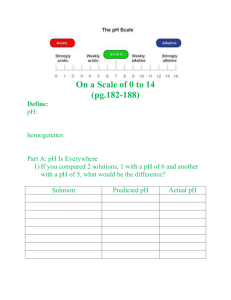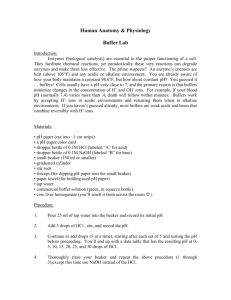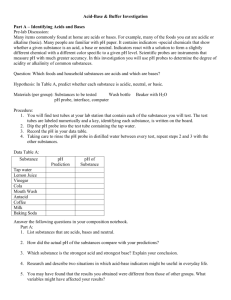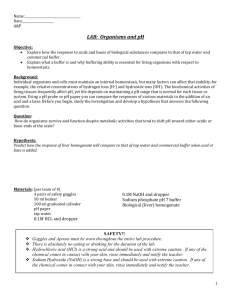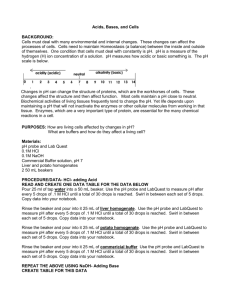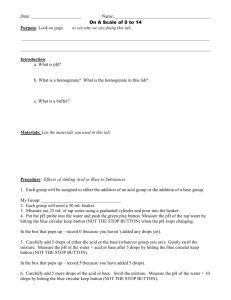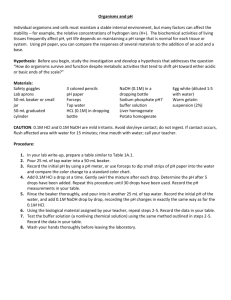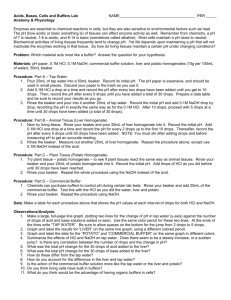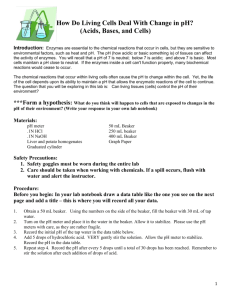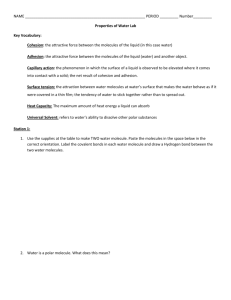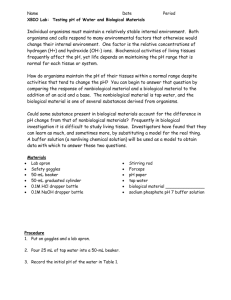Biology I Banerjee pH Lab.: On a Scale of 1
advertisement
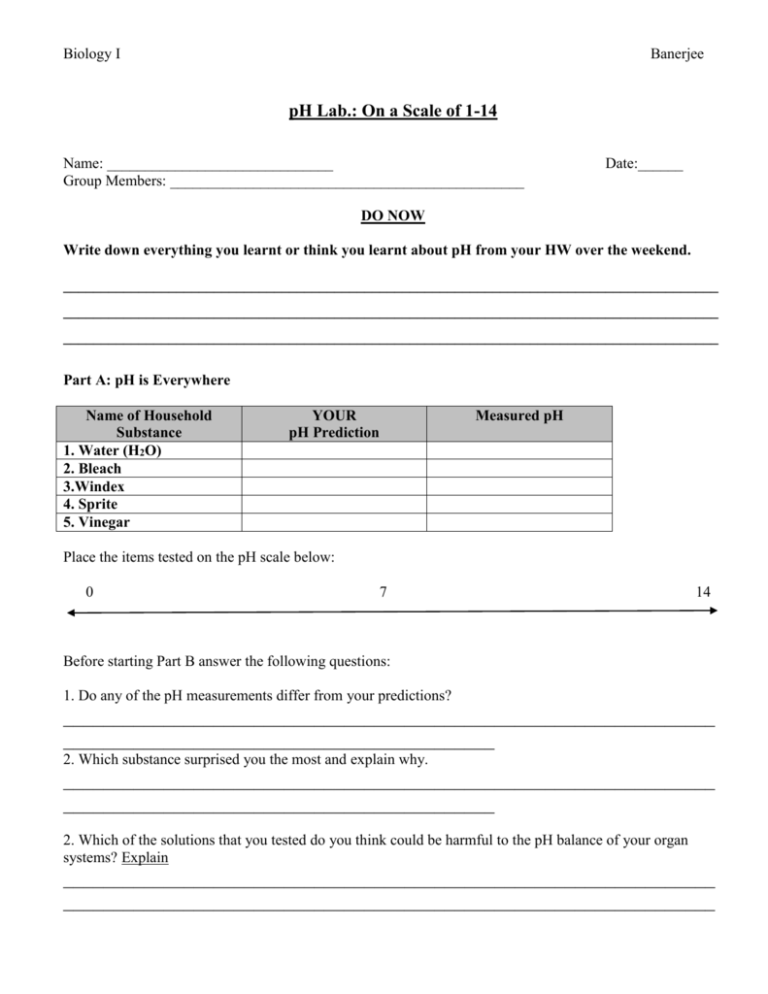
Biology I Banerjee pH Lab.: On a Scale of 1-14 Name: ______________________________ Group Members: _______________________________________________ Date:______ DO NOW Write down everything you learnt or think you learnt about pH from your HW over the weekend. _______________________________________________________________________________________ _______________________________________________________________________________________ _______________________________________________________________________________________ Part A: pH is Everywhere Name of Household Substance 1. Water (H2O) 2. Bleach 3.Windex 4. Sprite 5. Vinegar YOUR pH Prediction Measured pH Place the items tested on the pH scale below: 0 7 14 Before starting Part B answer the following questions: 1. Do any of the pH measurements differ from your predictions? _________________________________________________________________ ___________________________________________ 2. Which substance surprised you the most and explain why. _________________________________________________________________ ___________________________________________ 2. Which of the solutions that you tested do you think could be harmful to the pH balance of your organ systems? Explain _________________________________________________________________ _________________________________________________________________ Biology I Banerjee Part B: Regulating pH You will use this protocol to collect your data in this laboratory activity. Carefully read and follow the protocol AS WRITTEN. CAUTION: 0.1 M HCI is a mild irritant (an acid). Avoid skin and eye contact; do not ingest. If contact occurs, call the teacher immediately, and then flush the affected area with water for 15 minutes. Notify the teacher immediately. Initial after reading _______ 1. Pour 25 mL of distilled water into a 50-mL beaker. 2. Determine the initial pH of the solution as you did in part A. 3. Record the initial pH in a data table under the column labeled “0”. 4. Add 0.1 M HCI (hydrochloric acid) to the beaker, 1 drop at a time, until you have added 5 drops. Gently swirl the mixture after each drop. You are making the water more acidic. 5. Determine the pH of the solution. Record the pH in your data table. 6. Repeat steps 4 and 5. Record the pH after every additional 5 drops of acid until you have added a total of 30 drops of acid. 7. Discard the mixture in a sink and rinse the beaker and pH probe thoroughly with water. You will be observing how the cell homogenate responds to the addition of an acid and then a base. Repeat the procedures listed above for your cell homogenate. Dispose of homogenate in the appropriate container. 0 pH after Addition on 0.1 M HCl (Hydrochloric Acid) 5 10 15 20 25 30 Water Homogenate CAUTION: 0.1 M NaOH is a mild irritant (a base). Avoid skin and eye contact; do not ingest. If contact occurs, flush the affected area with water for 15 minutes; Notify the teacher immediately. Initial after reading _______ 1. Pour 25 mL of distilled water into a 50-mL beaker. 2. Determine the initial pH of the solution as you did in part A. 3. Record the initial pH in a data table under the column labeled “0”. 4. Add 0.1 M NaOH (sodium hydroxide), to the beaker, 1 drop at a time, until you have added 5 drops. Gently swirl the mixture after each drop. You are making the water more basic. 5. Determine the pH of the solution. Record the pH in your data table. 6. Repeat steps 4 and 5. Record the pH after every additional 5 drops of base until you have added a total of 30 drops of base. 7. Discard the mixture in a sink and rinse the beaker and pH probe thoroughly with water. You will be observing how the cell homogenate responds to the addition of an acid and then a base. Repeat the procedures listed above for your cell homogenate. Dispose of homogenate in the appropriate container. 0 Water Homogenate pH after Addition on 0.1 M NaOH (Sodium Hydroxide) 5 10 15 20 25 30 Biology I Banerjee 10. Rinse and dry your beaker,wipe down your lab bench, and return all materials. 11. Wash your hands thoroughly with soap and water after the experiment. Graph your collected data below: LEGEND: Your graph should include 4 lines to represent the following: Water + Acid _____________ (color of line) Water + Base _____________(color of line) Homogenate + Acid ____________(color of line) Homogenate + Base ____________ (color of line) Experimental Data 14 13 12 11 10 9 pH 8 7 6 5 4 3 2 1 0 0 5 10 15 20 25 30 35 Number of Drops Added How is the homogenate response to the addition of acid and base similar to, or different from the way water responded? Explain in full sentences. _________________________________________________________________ _________________________________________________________________ _________________________________________________________________ _________________________________________________________________ ________________________________________________________________ Biology I Banerjee With your lab partner read the background information on pages 183 and 188. What is a buffer? _________________________________________________________________ _________________________________________________________________ _________________________________________________________________ Analysis: 1. Based on your results and using water as a comparison, do you think cells are buffered? Explain your answer. _________________________________________________________________ _________________________________________________________________ _________________________________________________________________ _________________________________________________________________ _________________________________________________________________ _________________________________________________________________ 2. At what pH do you think these living cells function best? What evidence do you have to base this inference? _________________________________________________________________ _________________________________________________________________ _________________________________________________________________ _________________________________________________________________ _________________________________________________________________ _________________________________________________________________ __________________________________________ 3. Based on your data, how might a buffer help maintain homeostasis? Explain your answer. _________________________________________________________________ _________________________________________________________________ _________________________________________________________________ _________________________________________________________________ _________________________________________________________________ _________________________________________________________________ __________________________________________ 4. Many manufactures claim that their health care or hair products are pH balanced or buffered. How would you test their claim? _________________________________________________________________ _________________________________________________________________ _________________________________________________________________ _________________________________________________________________ ________________________________________________________________
